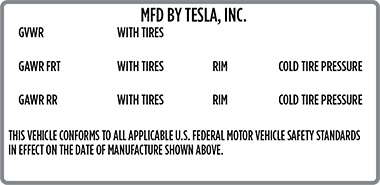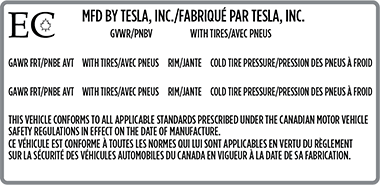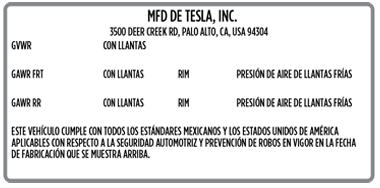Vehicle Loading
Vehicle Labeling
It is important to understand your vehicle's original tire sizes and pressures, and the TPMLM (Technically Permissible Maximum Label Mass) and TPMAM (Technically Permissible Maximum Mass on Axle). This information can be found on two labels attached to Model 3.
Both labels are visible on the door pillar when the front door is open.

- Tire and Loading Information Label
- Vehicle Certification Label
Tire and Loading Information Label
- The maximum number of occupant seating positions.
- The maximum vehicle capacity weight.
- The size of the original tires.
- The cold inflation pressures for the original front and rear tires. These pressures are recommended to optimize ride and handling characteristics.
Label Format:

Never change this label, even if you use different tires in the future.
Vehicle Certification Label
The Vehicle Certification label provides:
- - Gross Vehicle Weight Rating. The maximum allowable total mass of Model 3. This is calculated as the weight of Model 3 equipped with the heaviest factory selectable options, all passengers, fluids, and cargo.
- FRT and RR - Gross Axle Weight Rating for the front and rear axles. The is the maximum distributed weight that each axle can support.
United States:

Canada:

Mexico:

Towing a Trailer
Roof Racks
Model 3 supports the use of Tesla-approved roof racks using a Tesla mounting accessory. To install roof racks, you must use this accessory and you must use only roof rack systems that have been approved by Tesla (see Parts and Accessories). Failure to do so can cause significant damage.
Calculating Load Limits
- Locate the statement “The combined weight of occupants and cargo should never exceed XXX kg or XXX lbs.” on your vehicle's placard.
- Determine the combined weight of the driver and passengers that will be riding in your vehicle.
- Subtract the combined weight of the driver and passengers from XXX kg or XXX lbs.
- The resulting figure equals the available amount of cargo and luggage load capacity. For example, if the “XXX” amount equals 1400 lbs. and there will be five 150 lb passengers in your vehicle, the amount of available cargo and luggage load capacity is 650 lbs. (1400-750 (5 × 150) = 650 lbs.)
- Determine the combined weight of luggage and cargo being loaded on the vehicle. That weight may not safely exceed the available cargo and luggage load capacity calculated in Step 4.
- If your vehicle will be towing a trailer, load from your trailer will be transferred to your vehicle. Consult this manual to determine how this reduces the available cargo and luggage load capacity of your vehicle.
Example Load Limit Calculations
How much cargo Model 3 can carry depends on the number and weight of passengers. The following calculated load limit examples assume passengers weigh 150 lbs (68 kg). If passengers weigh more or less, available cargo weight decreases or increases respectively.
| Description | Total |
|---|---|
| Vehicle capacity weight | 954 lbs (433 kg) |
| Subtract occupant weight (2 x 150 lbs/68 kg) | 300 lbs (136 kg) |
| Available cargo weight | 654 lbs (297 kg) |
| Description | Total |
|---|---|
| Vehicle capacity weight | 954 lbs (433 kg) |
| Subtract occupant weight (5 x 150 lbs/68 kg) | 750 lbs (340 kg) |
| Available cargo weight | 204 lbs (93 kg) |
When carrying cargo, distribute the weight as evenly as possible between the front and rear trunks. For maximum load limits specific to the trunks, see Front Trunk Load Limit and Rear Trunk Load Limits.